Essential Safety Guide: Protecting Your Child from Hidden Chemicals in New Clothing
When you bring home that adorable new outfit for your toddler, you might wonder if you really need to wash it first. You should always wash toddler clothes before your child wears them for the first time to remove harmful chemicals, dust, and potential irritants from manufacturing and shipping. Even clothes that look perfectly clean can carry residues that might irritate your child’s sensitive skin.
This isn’t just about keeping clothes looking nice. It’s about protecting your child’s health and comfort. Research shows that washing new clothes removes up to 60% of potentially harmful chemicals, making this simple step one of the most important things you can do for your toddler’s wellbeing.
The American Academy of Pediatrics recommends washing all baby clothes before first use, especially since newborns tend to have sensitive skin and you don’t know who has handled the clothing before it reached you.
Table of Contents
Key Takeaways
- Always wash new toddler clothes before the first wear
- Use gentle, fragrance-free detergents designed for sensitive skin
- Wash all secondhand clothes and hand-me-downs thoroughly
- Pre-wash clothes 4-6 weeks before your baby’s due date for optimal timing
- Look for OEKO-TEX certified clothing when shopping for safer options
Why You Must Wash Toddler Clothes Before First Use
Many parents are discovering the importance of pre-washing through social media, where real experiences and expert advice are helping spread awareness about this crucial safety step.
This growing awareness among parents highlights why pre-washing has become such an important topic in parenting communities. Now let’s dive into the science behind why this step is so critical.
The Hidden Chemical Reality
New clothes aren’t as clean as they appear. During manufacturing, textiles are treated with various chemicals to maintain their appearance during shipping and storage. According to research published in peer-reviewed journals, formaldehyde was detected in 20% of baby and children’s clothing samples tested, with average levels of 8.96 mg/kg.
The International Agency for Research on Cancer has classified formaldehyde as “carcinogenic to humans,” making pre-washing even more critical. What’s particularly concerning is that studies found formaldehyde levels were actually higher in eco-friendly clothing (10.4 mg/kg) compared to conventional garments (8.23 mg/kg), proving that “organic” doesn’t automatically mean chemical-free.
Manufacturing and Shipping Contaminants
Your toddler’s new clothes have traveled through multiple facilities before reaching your hands. During this journey, they can pick up:
- Factory residues: Chemicals used in dyeing, finishing, and wrinkle-resistance treatments
- Warehouse dust and dirt: Particles that accumulate during storage
- Shipping contaminants: Various substances encountered during transport
- Store handling: Residues from other shoppers trying on clothes
Dr. Daniel Ganjian, MD, FAAP, a board-certified pediatrician at Providence Saint John’s Health Center, emphasizes that you simply can’t know what germs or chemicals clothes were exposed to during manufacturing, distribution, and delivery.
Health Risks for Sensitive Skin
Toddlers have particularly vulnerable skin that’s still developing its natural protective barrier. This makes them highly susceptible to:
- Contact dermatitis: Rashes and irritation from chemical residues
- Allergic reactions: Responses to dyes, preservatives, and fabric treatments
- Respiratory issues: From inhaling chemical fumes released by untreated fabrics
- Hormone disruption: From chemicals like phthalates that can interfere with normal development
Environmental Working Group testing found fluorine (indicating PFAS “forever chemicals”) in all 34 baby textile samples tested, with some products showing very high concentrations of these persistent, potentially toxic compounds.
Dangerous Chemicals Hiding in New Clothes
The reality of what’s hiding in your child’s new clothes is more concerning than most parents realize. Here’s a breakdown of the most common harmful chemicals found in baby and toddler clothing:
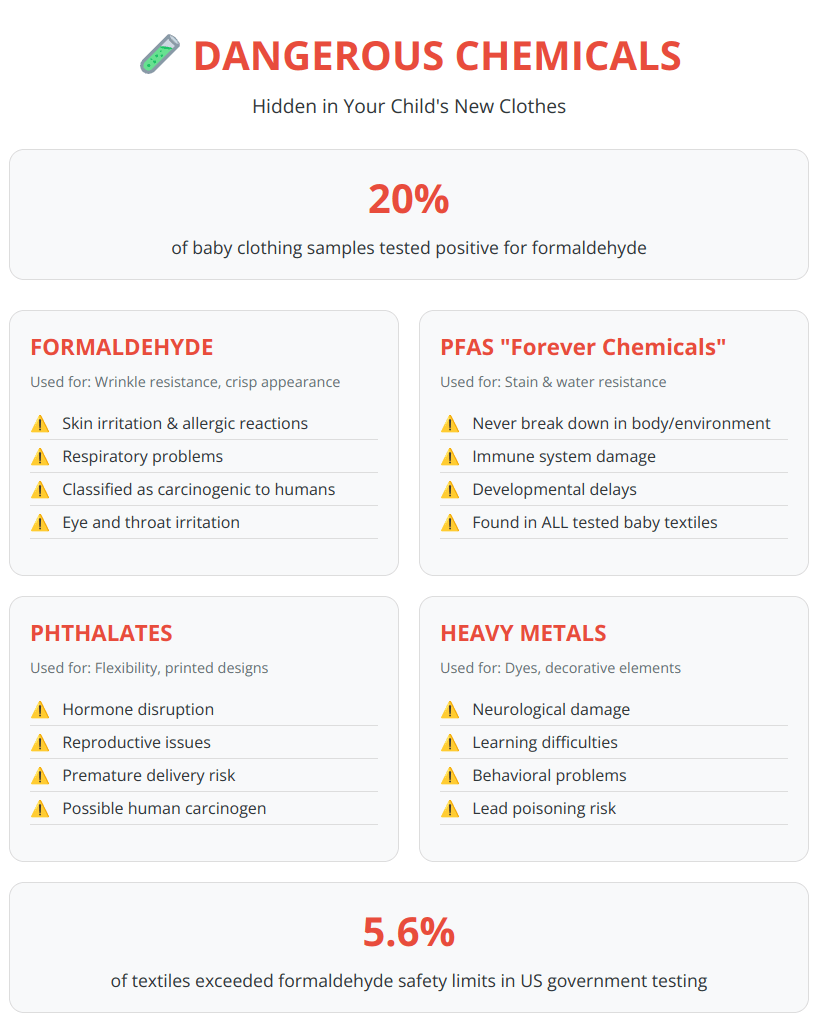
Understanding these hidden dangers emphasizes why pre-washing is such a critical step in protecting your child’s health.
Formaldehyde: The Embalming Chemical in Your Child’s Wardrobe
Formaldehyde is commonly used to make clothes wrinkle-resistant and maintain their crisp appearance. The same chemical used in embalming fluids can cause:
- Skin irritation and allergic reactions
- Respiratory problems and throat irritation
- Increased cancer risk with prolonged exposure
- Eye and nose irritation
A U.S. Government Accountability Office investigation found that 5.6% of textile samples exceeded the formaldehyde safety limit of 75 parts per million, with some samples showing levels as high as 206.1 ppm.
PFAS: The “Forever Chemicals”
Per- and polyfluoroalkyl substances (PFAS) are used in stain-resistant and waterproof fabrics. These chemicals:
- Never break down in the environment or human body
- Accumulate over time, causing potential health problems
- Have been linked to immune system damage and developmental delays
- Are found in everything from bibs to outerwear
Phthalates and Other Hormone Disruptors
These chemicals make plastics flexible and are found in printed designs and waterproof coatings. The U.S. Environmental Protection Agency classifies phthalates as possible human carcinogens, and studies link them to:
- Hormone disruption and reproductive issues
- Premature delivery in pregnant women
- Decreased sperm quality in men
- Developmental problems in children
Heavy Metals and Toxic Dyes
Some clothing contains heavy metals like lead, especially in decorative elements and bright colors. These can cause:
- Neurological damage and developmental delays
- Learning difficulties and behavioral problems
- Poisoning if absorbed through the skin over time
Myths vs. Facts About “Safe” Clothing
Many well-meaning parents fall for common misconceptions about clothing safety. Let’s separate fact from fiction:
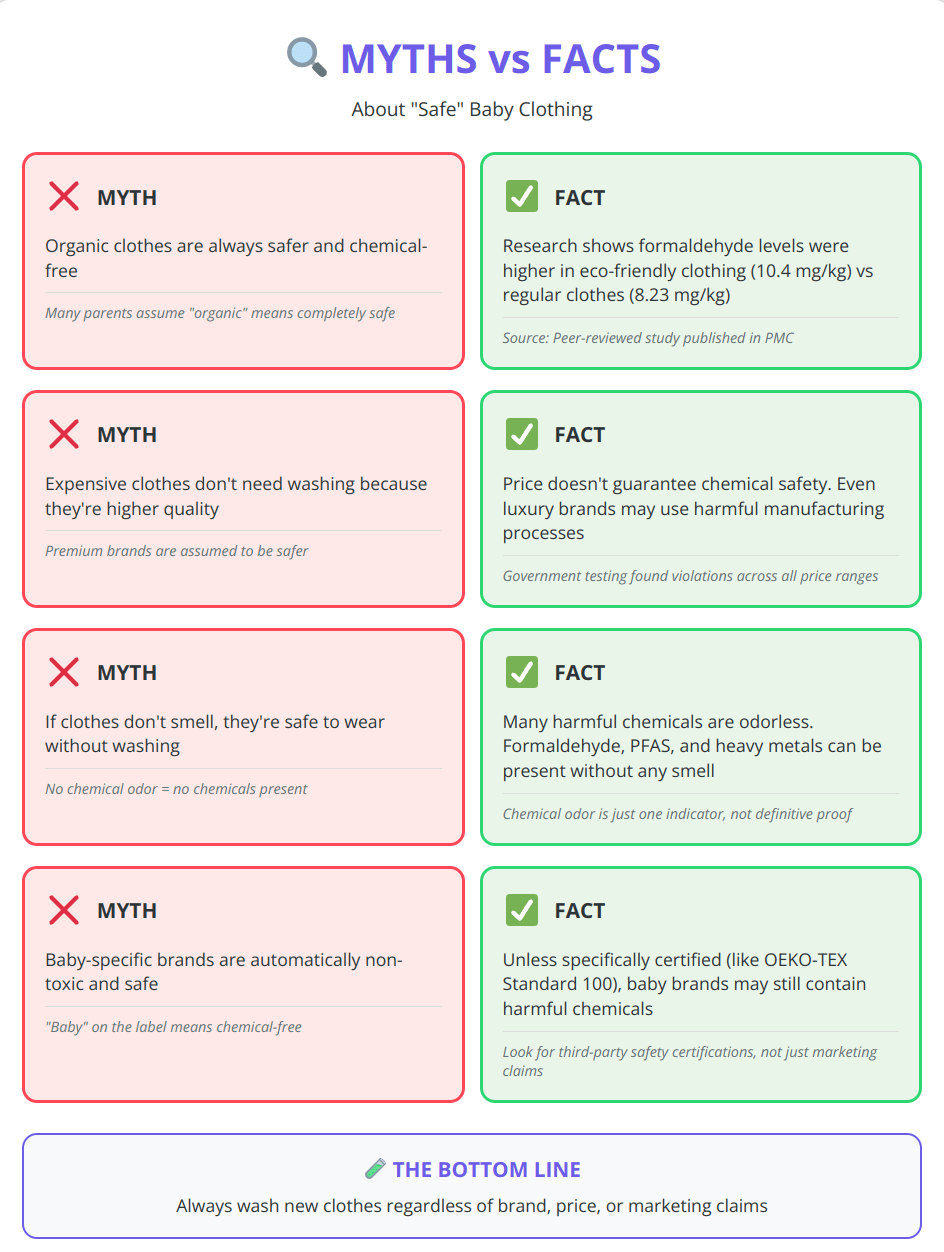
These misconceptions can put your child at risk, which is why it’s essential to rely on scientific evidence rather than marketing claims.
Myth: Organic Clothes Are Always Safer
Fact: Research shows formaldehyde levels were surprisingly higher in eco-friendly garments than regular clothing. “Organic cotton” only refers to pesticide-free farming, not chemical-free processing.
Myth: Expensive Clothes Don’t Need Washing
Fact: Price doesn’t guarantee chemical safety. Even premium brands may use harmful substances in manufacturing.
Myth: If It Doesn’t Smell, It’s Safe
Fact: Many harmful chemicals are odorless. A chemical smell is just one indicator of potential problems.
Myth: Baby-Specific Brands Are Always Non-Toxic
Fact: Unless specifically certified (like OEKO-TEX Standard 100), baby brands may still contain harmful chemicals.
Optimal Timing: When to Pre-Wash Baby and Toddler Clothes
Getting the timing right for pre-washing ensures your clothes stay clean without sitting around collecting dust. Here’s the expert-recommended timeline:
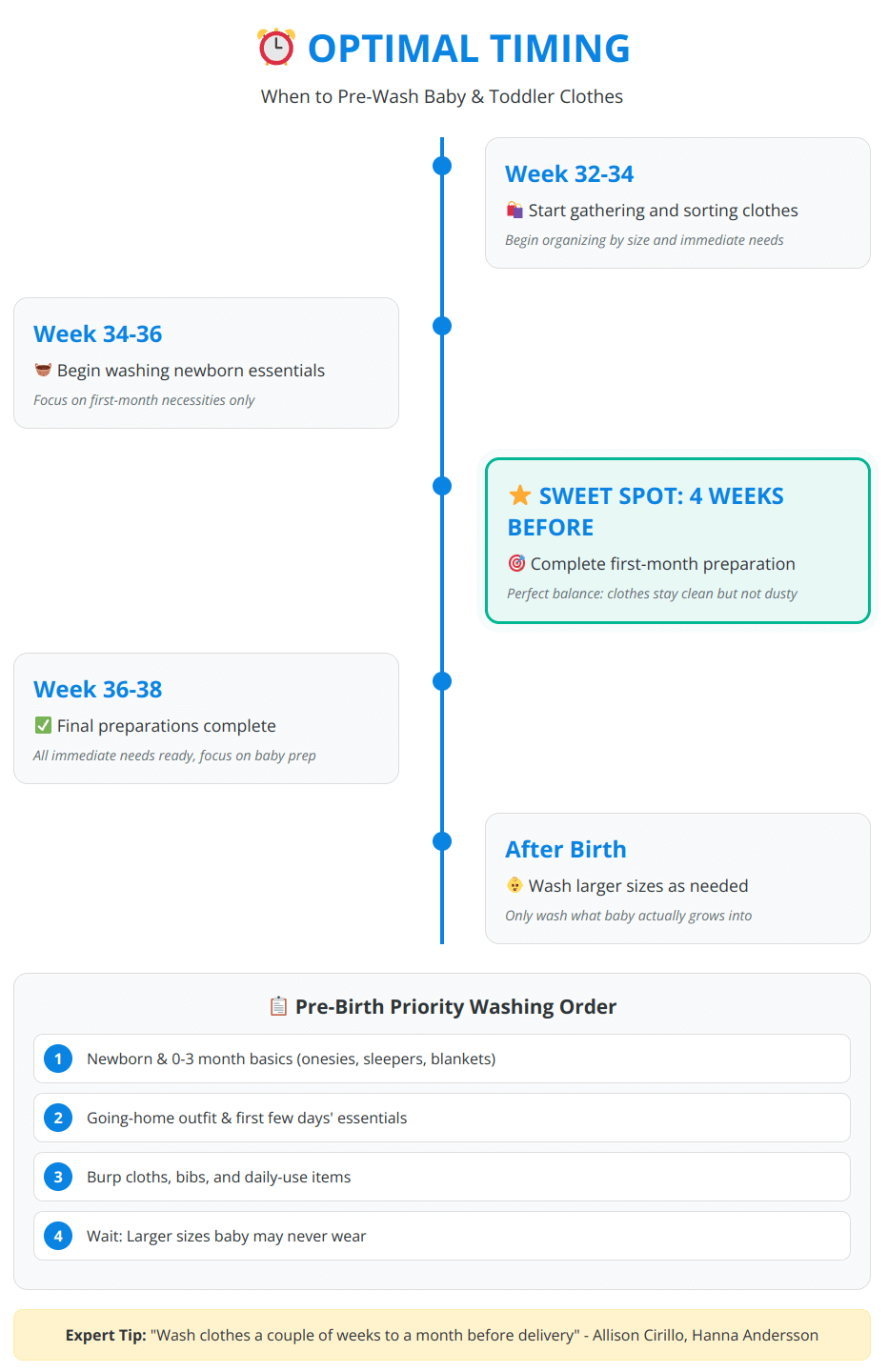
Following this timeline ensures you’re prepared without wasting effort on clothes your baby might never wear.
The 4-6 Week Rule
According to Allison Cirillo, senior director of product integrity and technical design at Hanna Andersson, you should wash baby clothes “a couple of weeks to a month before delivery.” The ideal window is:
- No earlier than 6 weeks before: Prevents clothes from collecting dust while sitting clean
- No later than 2 weeks before: Ensures you have time to rewash if needed
- Sweet spot: 4 weeks before due date balances cleanliness with practicality
Use our free Pre-Washing Timeline Calculator to get your personalized washing schedule based on your due date.
What to Wash When
Pre-Birth Priority List:
- Newborn and 0-3 month basics (onesies, sleepers, blankets)
- Going-home outfit and first few days’ essentials
- Burp cloths, bibs, and daily-use items
Wait to Wash:
- Larger sizes your baby may never wear
- Special occasion outfits
- Items you’re unsure about keeping
Signs You’ve Waited Too Long
If you notice these issues, wash clothes immediately:
- Musty or chemical odors
- Visible dust accumulation
- Clothes feel stiff or have a coating
- Any discoloration or staining
Choosing the Right Detergent for Toddler Clothes
Selecting the right detergent is crucial for your toddler’s safety and comfort. Here’s what you need to know about choosing baby-safe options:
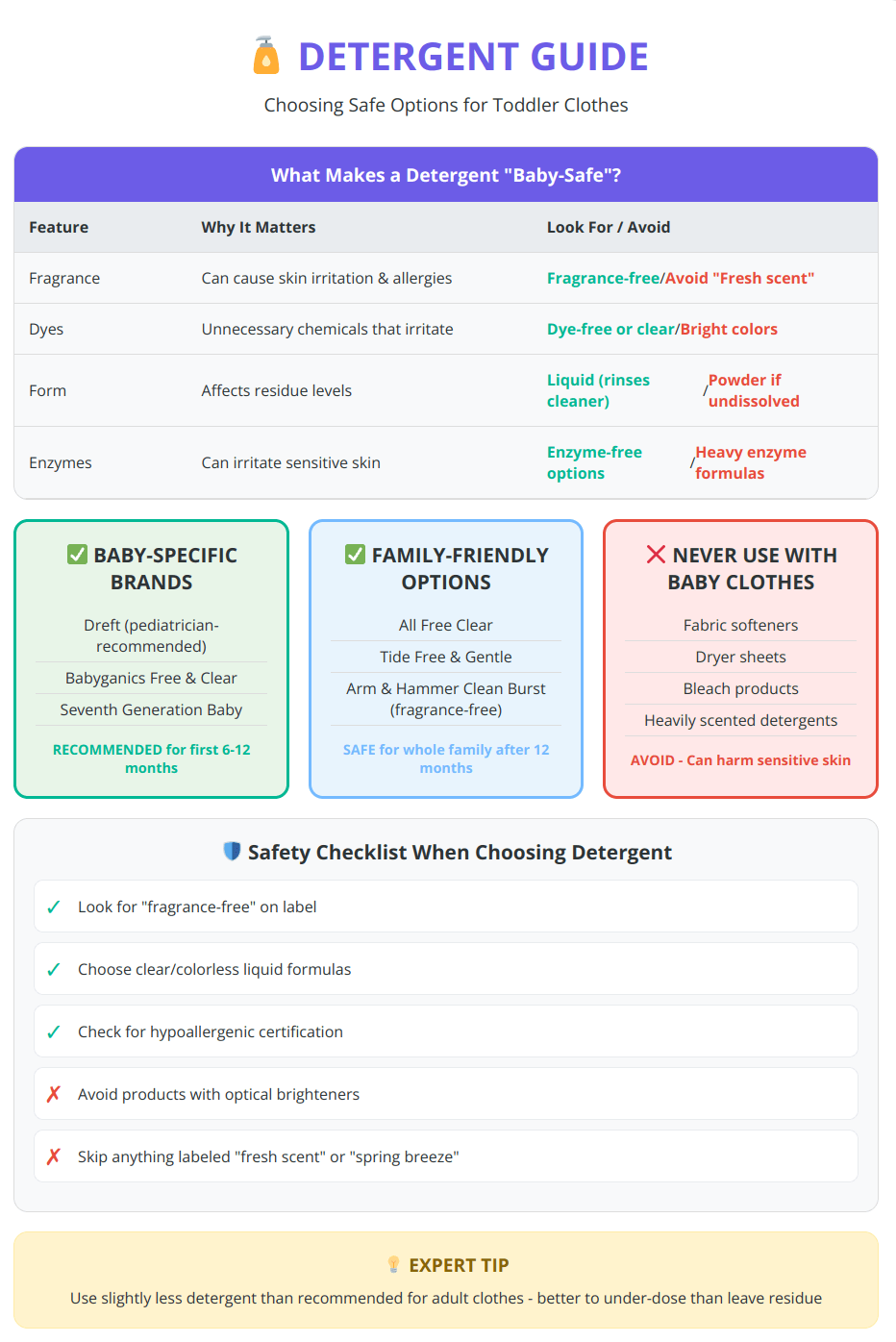
Remember, the gentlest option that effectively cleans is always the best choice for your child’s sensitive skin.
What Makes a Detergent “Baby-Safe”
Look for detergents that are:
- Fragrance-free: Artificial scents can trigger allergies and skin reactions
- Dye-free: Colorants serve no cleaning purpose and may cause irritation
- Hypoallergenic: Formulated to minimize allergic reactions
- Free of optical brighteners: These chemicals can irritate sensitive skin
According to the #1 detergent brand recommended by dermatologists, allergists, and pediatricians for sensitive skin, you can use gentle “free and clear” formulations for the whole family.
Detergent Comparison Chart
| Feature | Why It Matters | Look For | Avoid |
|---|---|---|---|
| Fragrance | Can cause skin irritation | “Fragrance-free” | “Fresh scent,” “Spring breeze” |
| Dyes | Unnecessary chemicals | “Dye-free” or clear liquid | Bright colored detergents |
| Enzymes | Can irritate sensitive skin | “Enzyme-free” options | Heavy enzyme formulations |
| Form | Affects residue levels | Liquid (rinses cleaner) | Powder (if not fully dissolved) |
Top-Rated Options
Baby-Specific Brands:
- Dreft (pediatrician-recommended)
- Babyganics Free & Clear
- Seventh Generation Baby
Family-Friendly Options:
- All Free Clear
- Tide Free & Gentle
- Arm & Hammer Clean Burst (fragrance-free version)
Products to Avoid Completely
Never use these with toddler clothes:
- Fabric softeners (reduce flame resistance and leave chemical residue)
- Dryer sheets (contain harsh fragrances and chemicals)
- Bleach (too harsh for sensitive skin and can damage fabrics)
- Heavily scented detergents (can trigger allergic reactions)
Step-by-Step Guide: How to Properly Wash Toddler Clothes
Follow this comprehensive step-by-step process to ensure your toddler’s clothes are properly cleaned and safe:
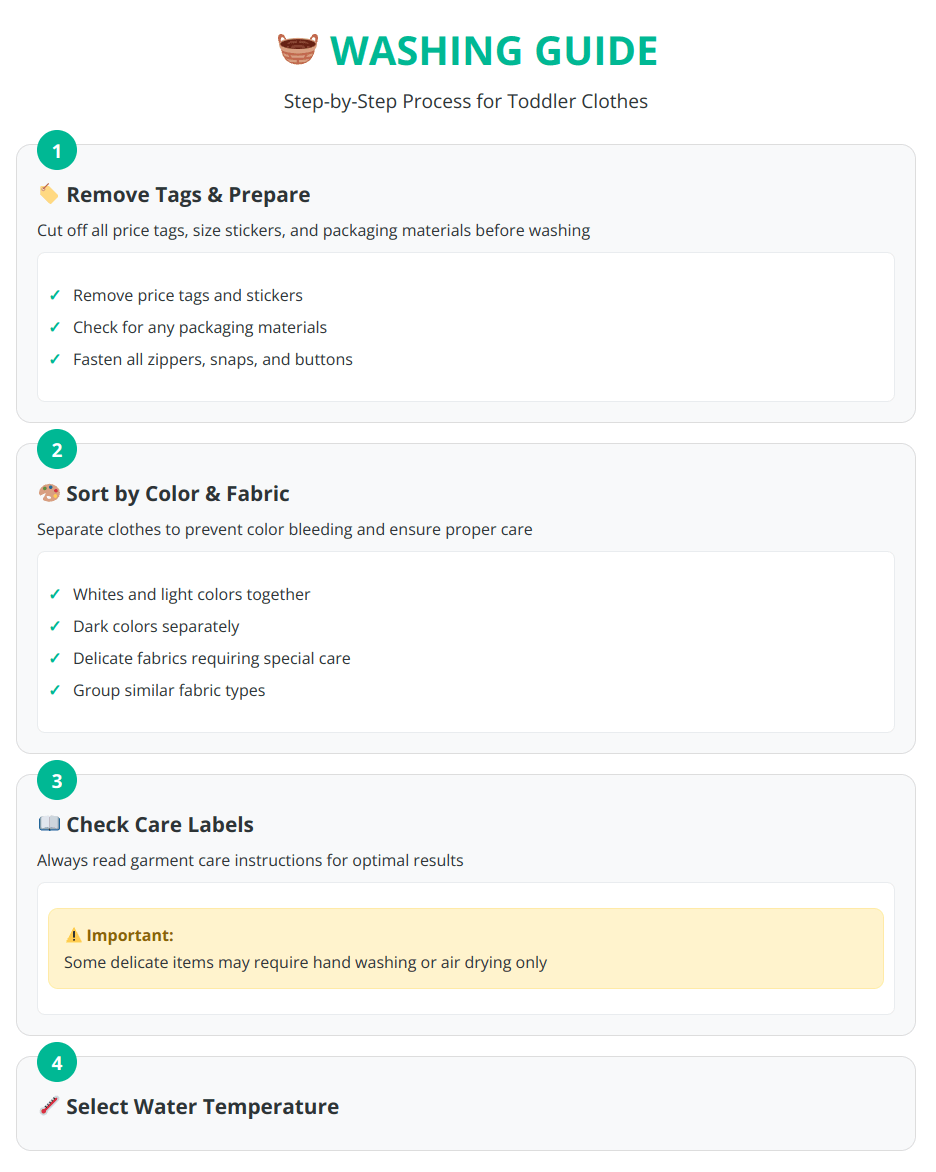
Following these steps consistently will give you confidence that your child’s clothes are as safe and clean as possible.
Pre-Washing Preparation
Step 1: Remove All Tags and Stickers Cut off price tags, size stickers, and any packaging materials. These often leave sticky residue that’s harder to remove after washing.
Step 2: Sort by Color and Fabric Type
- Whites and light colors together
- Dark colors separately
- Delicate items requiring special care
- Different fabric types may need different treatments
Step 3: Check Care Labels Always read garment care instructions, especially for:
- Special washing temperatures
- Drying restrictions
- Fabric-specific requirements
Washing Process
Temperature Guidelines:
- Cold water (30°C/86°F): Best for most toddler clothes, prevents shrinking
- Warm water (40°C/104°F): For heavily soiled items or when label permits
- Hot water: Only when specifically required and safe for fabric
Cycle Settings:
- Use gentle or delicate cycle for most items
- Normal cycle only for sturdy cotton fabrics
- Avoid heavy-duty cycles that can damage delicate toddler clothes
Detergent Amount:
- Use slightly less than recommended for adult clothes
- Better to under-dose than leave residue on fabric
- Add extra rinse cycle if your machine allows
Special Techniques for Small Items
Using Mesh Laundry Bags: Essential for:
- Tiny socks and mittens
- Bibs with strings or ties
- Delicate items with small parts
- Anything you don’t want to lose in the wash
Hand Washing When Necessary: Some items require hand washing:
- Fill basin with lukewarm water
- Add small amount of gentle detergent
- Gently agitate for 2-3 minutes
- Soak for 15-30 minutes
- Rinse thoroughly with clean water
- Press (don’t wring) to remove excess water
Drying Best Practices for Toddler Clothes
How you dry your toddler’s clothes is just as important as how you wash them. Here’s your complete guide to safe drying methods:
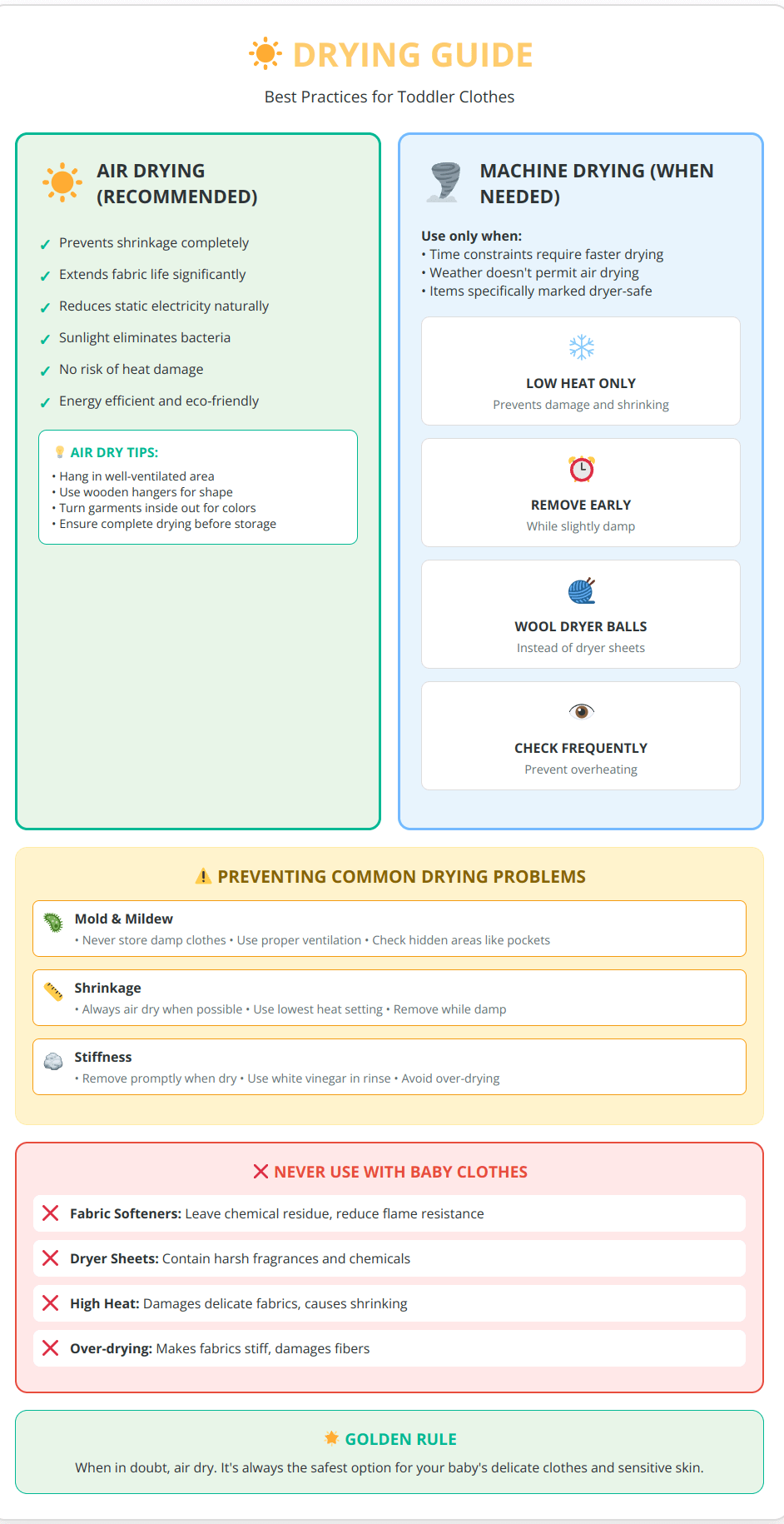
Remember, gentle drying methods not only protect your child’s clothes but also ensure they remain safe and comfortable to wear.
Air Drying vs. Machine Drying
Air Drying Benefits:
- Prevents shrinkage
- Extends fabric life
- Reduces static electricity
- Natural sunlight helps eliminate lingering bacteria
- No risk of heat damage
When to Use the Dryer:
- Time constraints require faster drying
- Weather doesn’t permit air drying
- Items specifically marked as dryer-safe
Dryer Settings for Toddler Clothes:
- Low heat only
- Remove items while slightly damp to prevent over-drying
- Use wool dryer balls instead of dryer sheets
- Check frequently to prevent overheating
Preventing Common Drying Problems
Avoiding Mold and Mildew:
- Never put away damp clothes
- Ensure complete drying before storage
- Use proper ventilation in drying area
- Check hidden areas like inside pockets
Maintaining Softness:
- Remove clothes promptly when dry
- Fold immediately to prevent wrinkles
- Use natural fabric softener alternatives like white vinegar in rinse cycle
Tackling Stains and Tough Messes
Toddlers are master mess-makers, but with the right techniques, even the toughest stains don’t have to be permanent. Here’s your stain-fighting arsenal:
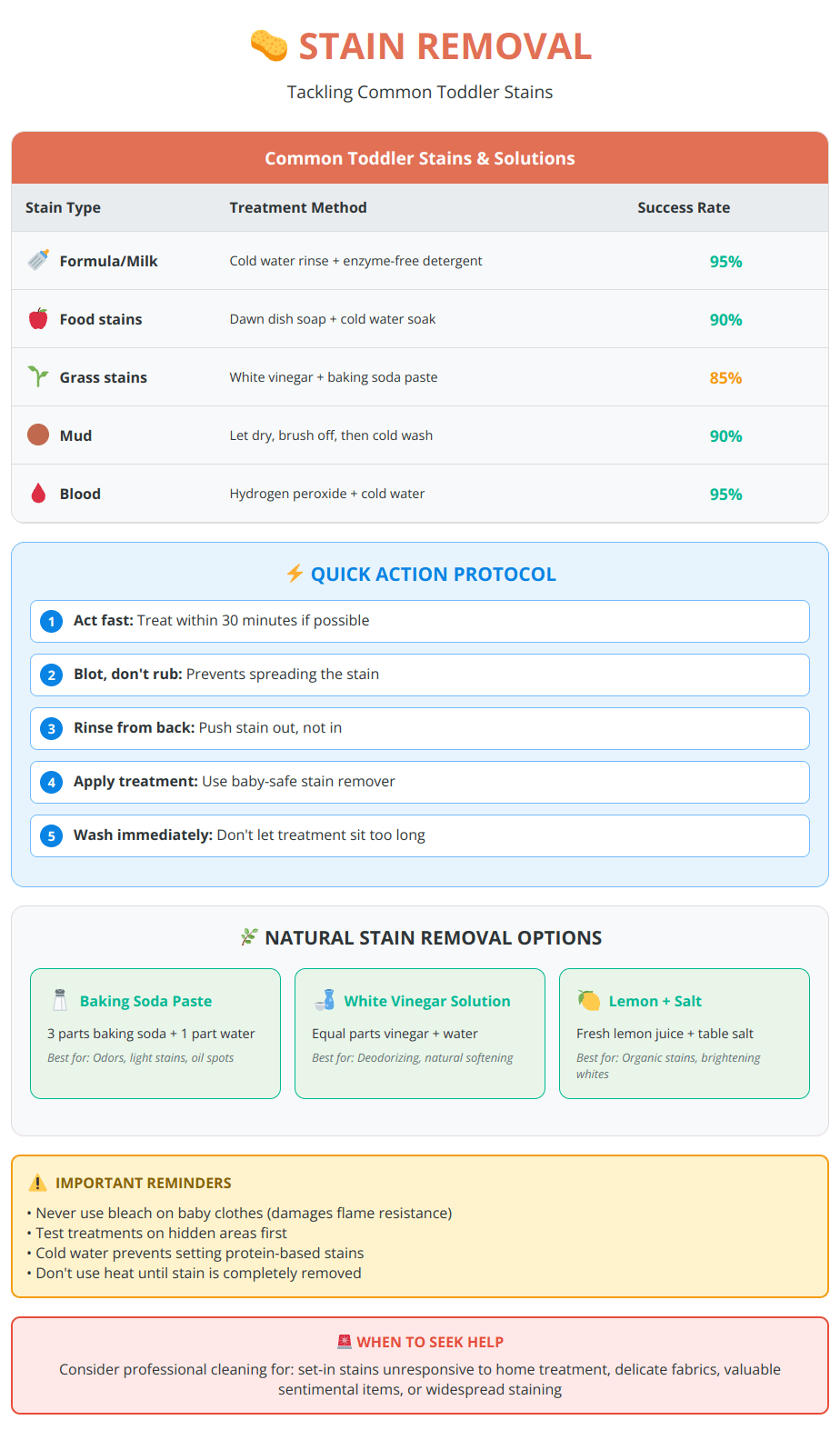
With these proven methods, you’ll be prepared for whatever stains your little one can create.
Pre-Treatment Strategies
For Fresh Stains:
- Act quickly – within 30 minutes if possible
- Blot, don’t rub, to avoid spreading
- Rinse with cold water from the back of the fabric
- Apply gentle, baby-safe stain remover
Common Toddler Stains and Solutions:
| Stain Type | Treatment Method | Success Rate |
|---|---|---|
| Formula/Milk | Cold water rinse + enzyme-free detergent | 95% |
| Food stains | Dawn dish soap + cold water soak | 90% |
| Grass stains | White vinegar + baking soda paste | 85% |
| Mud | Let dry, brush off, then cold wash | 90% |
| Blood | Hydrogen peroxide + cold water | 95% |
Natural Stain Removal Options
Baking Soda Paste:
- Mix 3 parts baking soda with 1 part water
- Apply to stain and let sit 30 minutes
- Gentle scrub with soft brush
- Rinse and wash normally
White Vinegar Solution:
- Mix equal parts white vinegar and water
- Soak stained area for 15 minutes
- Rinse thoroughly before washing
- Natural deodorizer and softener
When to Seek Professional Help
Some stains require professional cleaning:
- Set-in stains that haven’t responded to home treatment
- Delicate fabrics that might be damaged by home remedies
- Valuable or sentimental items
- Large or widespread staining
Special Considerations for Different Clothing Types
Different types of baby clothing require different levels of care and attention. Here’s your priority guide:
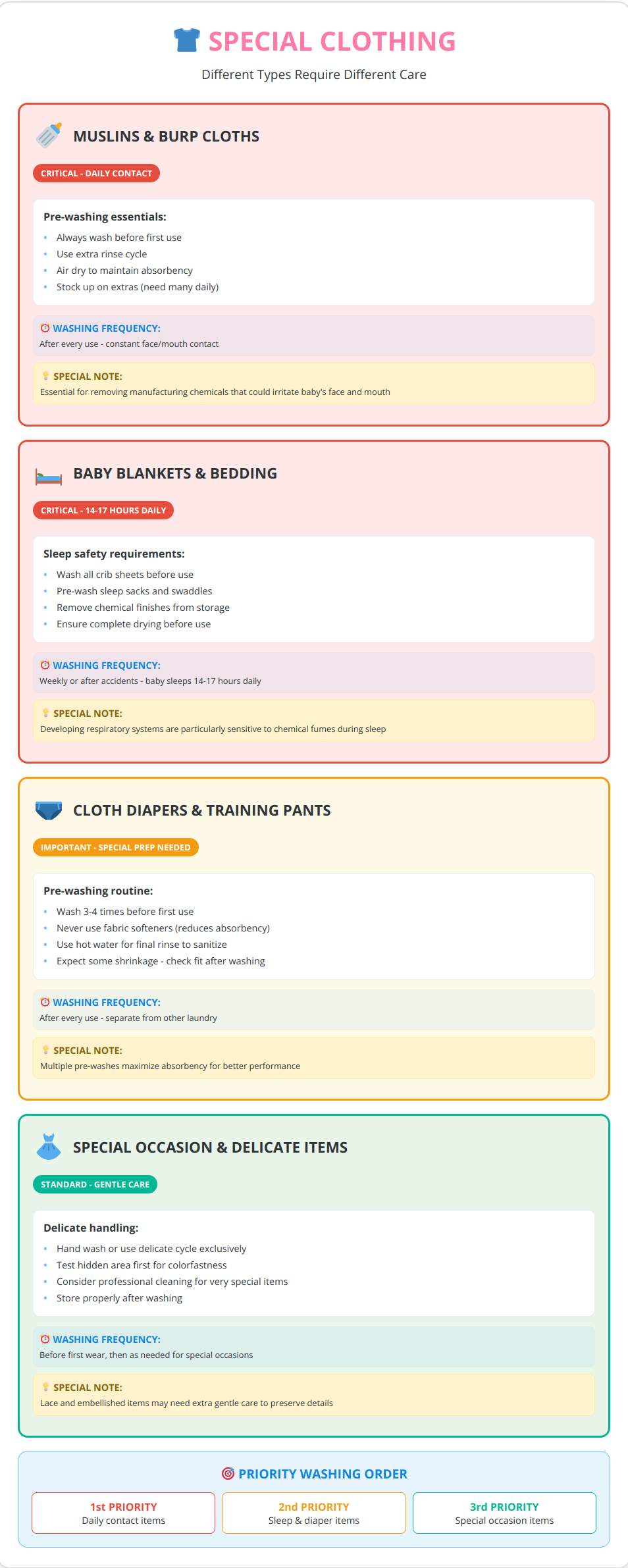
Understanding these different requirements helps you allocate your time and attention where it’s needed most.
Muslins and Burp Cloths
Do you need to wash muslins before use? Absolutely. Muslins are in constant contact with your baby’s face and mouth, making pre-washing essential. These soft fabrics for sensitive skin require gentle handling but thorough cleaning.
Pre-washing tips for muslins:
- Wash before first use to remove manufacturing residues
- Use extra rinse cycle to ensure no detergent remains
- Air dry to maintain softness and absorbency
- Stock up on extras since you’ll need many throughout the day
Baby Blankets and Bedding
Do you need to wash baby blankets before use? Yes, especially since babies spend 14-17 hours daily sleeping. Pre-washing removes:
- Chemical finishes applied for store display
- Dust and particles from storage and transport
- Potential allergens that could disrupt sleep
Should you wash new bedding before use? Always wash crib sheets, mattress protectors, and sleep sacks before your baby uses them. Their developing respiratory systems are particularly sensitive to chemical fumes.
Cloth Diapers and Training Pants
Reusable toddler pants for potty training require special attention:
Pre-washing routine:
- Wash 3-4 times before first use to maximize absorbency
- Avoid fabric softeners permanently (reduces absorbency)
- Use hot water for final rinse to sanitize
- Check for proper fit after washing, as some shrinkage is normal
Special Occasion and Delicate Items
For dressy outfits, lace fabrics, and delicate items:
- Hand wash or use delicate cycle exclusively
- Test a hidden area first if unsure about colorfastness
- Consider professional cleaning for very special items
- Store properly after washing to maintain appearance
Safety Certifications to Look For
When shopping for toddler clothes, look for these trusted safety certifications that guarantee rigorous testing:

These certifications provide peace of mind that the clothes have been independently tested for your child’s safety.
OEKO-TEX Standard 100: The Gold Standard
According to the U.S. Consumer Product Safety Commission, children’s products must comply with federal safety rules and undergo third-party testing to ensure they meet strict safety standards before reaching consumers.
OEKO-TEX Standard 100 is one of the world’s most recognized certifications for textiles tested for harmful substances. Products with this certification have been tested for over 100 harmful chemicals and substances.
What OEKO-TEX guarantees:
- No harmful levels of formaldehyde, heavy metals, or pesticides
- No azo dyes that can release carcinogenic aromatic amines
- No chlorinated phenols or tin-organic compounds
- Testing of every component, including buttons, zippers, and threads
OEKO-TEX Classes:
- Class I: Baby products (most stringent standards)
- Class II: Direct skin contact items
- Class III: No direct skin contact
- Class IV: Decoration materials
GOTS (Global Organic Textile Standard)
GOTS certification ensures:
- Organic fiber content (minimum 70%)
- Environmental and social criteria
- Chemical restrictions throughout supply chain
- Transparent and traceable production
Other Trusted Certifications
GREENGUARD Gold:
- Low chemical emissions
- Suitable for sensitive individuals
- Strict indoor air quality standards
Cradle to Cradle Certified:
- Safe for human and environmental health
- Renewable energy use
- Water stewardship practices
Age-Specific Guidelines and Transition Periods
As your child grows, their laundry needs evolve too. Here’s when and how to safely transition your washing routine:
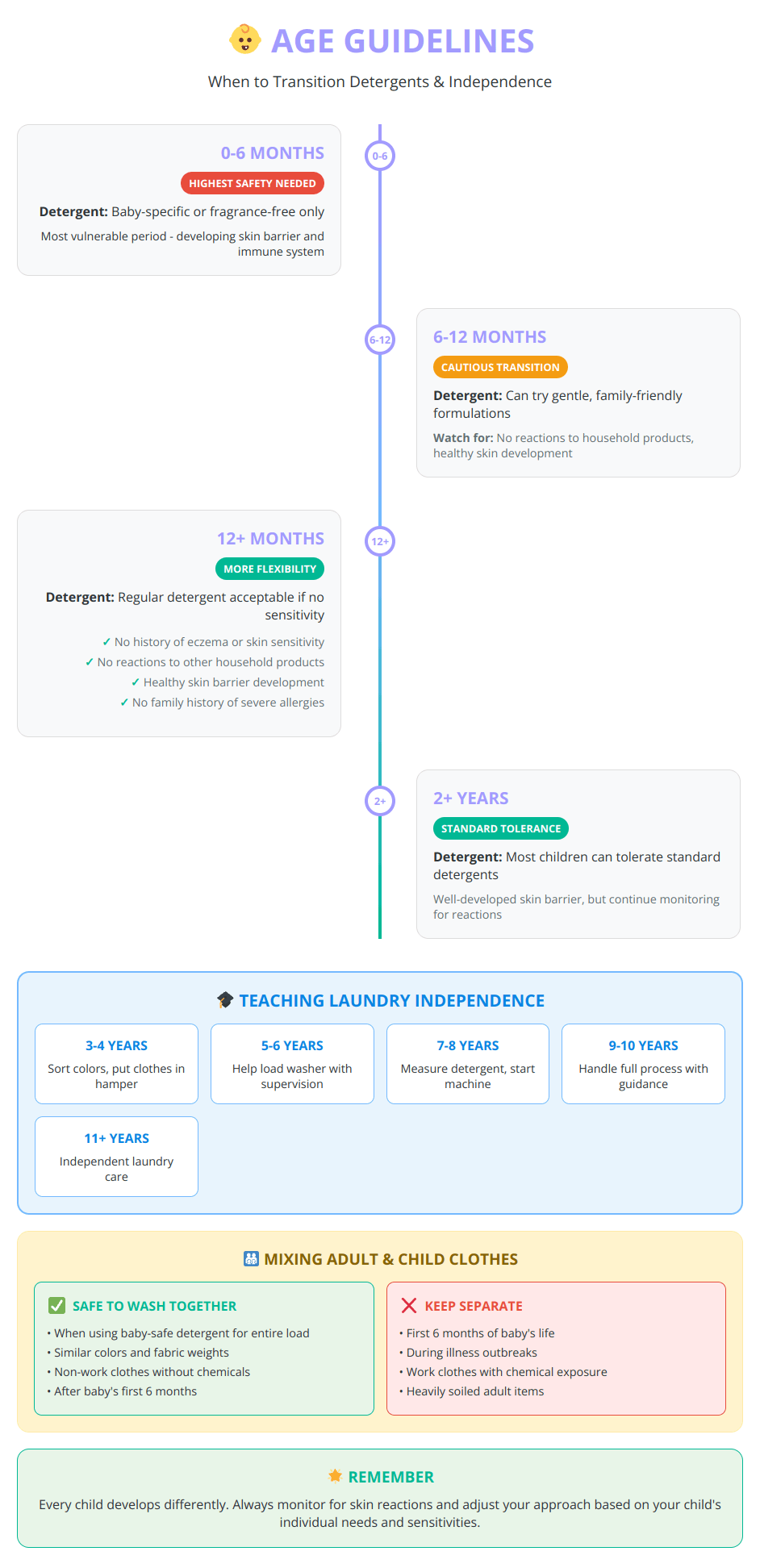
Understanding these age-based guidelines helps you make informed decisions about your child’s clothing care as they develop.
When Can You Use Regular Detergent?
At what age can you wash baby clothes in regular detergent? Most pediatricians recommend:
- 0-6 months: Baby-specific or fragrance-free detergents only
- 6-12 months: Can try gentle, family-friendly formulations
- 12+ months: Regular detergent acceptable if child shows no sensitivity
- 2+ years: Most children can tolerate standard detergents
Signs your child is ready for regular detergent:
- No history of eczema or skin sensitivity
- No reactions to other household products
- Healthy skin barrier development
- No family history of severe allergies
Transitioning to Independent Care
At what age should a child start washing their own clothes?
- 3-4 years: Can help sort colors and put clothes in hamper
- 5-6 years: Can help load washer with supervision
- 7-8 years: Can learn to measure detergent and start machine
- 9-10 years: Can handle full washing process with guidance
- 11+ years: Should be capable of independent laundry care
Teaching progression:
- Start with sorting and folding
- Explain why we separate colors
- Show how to check pockets
- Demonstrate measuring detergent
- Teach machine settings and safety
Mixing Adult and Child Clothes
Can you wash toddler clothes with adult clothes? Yes, but with considerations:
Safe to wash together:
- When using baby-safe detergent for entire load
- Items of similar colors and fabric weights
- Non-work clothes without heavy soil or chemicals
Keep separate:
- First 6 months of baby’s life
- During illness outbreaks
- Work clothes with chemical exposure
- Heavily soiled adult items
Quick Reference: What Baby Items Need Pre-Washing
Use this handy reference guide to quickly determine which baby items require pre-washing and which don’t:

Keep this reference handy when preparing for your baby’s arrival or when friends ask what they should wash before use.
Essential Pre-Wash Items
Clothing:
- All onesies, sleepers, and everyday wear
- Bibs, burp cloths, and feeding accessories
- Socks, hats, and mittens
- Newborn and infant clothing essentials
Bedding and Sleep Items:
- Crib sheets and mattress protectors
- Sleep sacks and swaddles
- Receiving blankets
- Stuffed animals that will be in the crib
Feeding and Care Items:
- Cloth bibs and burp cloths
- Washcloths and towels
- Any fabric items used during feeding or bathing
Items That Don’t Require Pre-Washing
Non-fabric items:
- Bottles, pacifiers, and feeding utensils
- Plastic toys and rattles
- Diapers (disposable)
- Car seat and stroller (unless fabric covers)
Heavy Metal Contamination: Lead in Children’s Clothing
Lead contamination in children’s clothing is a serious but often overlooked danger. Here’s what every parent needs to know:
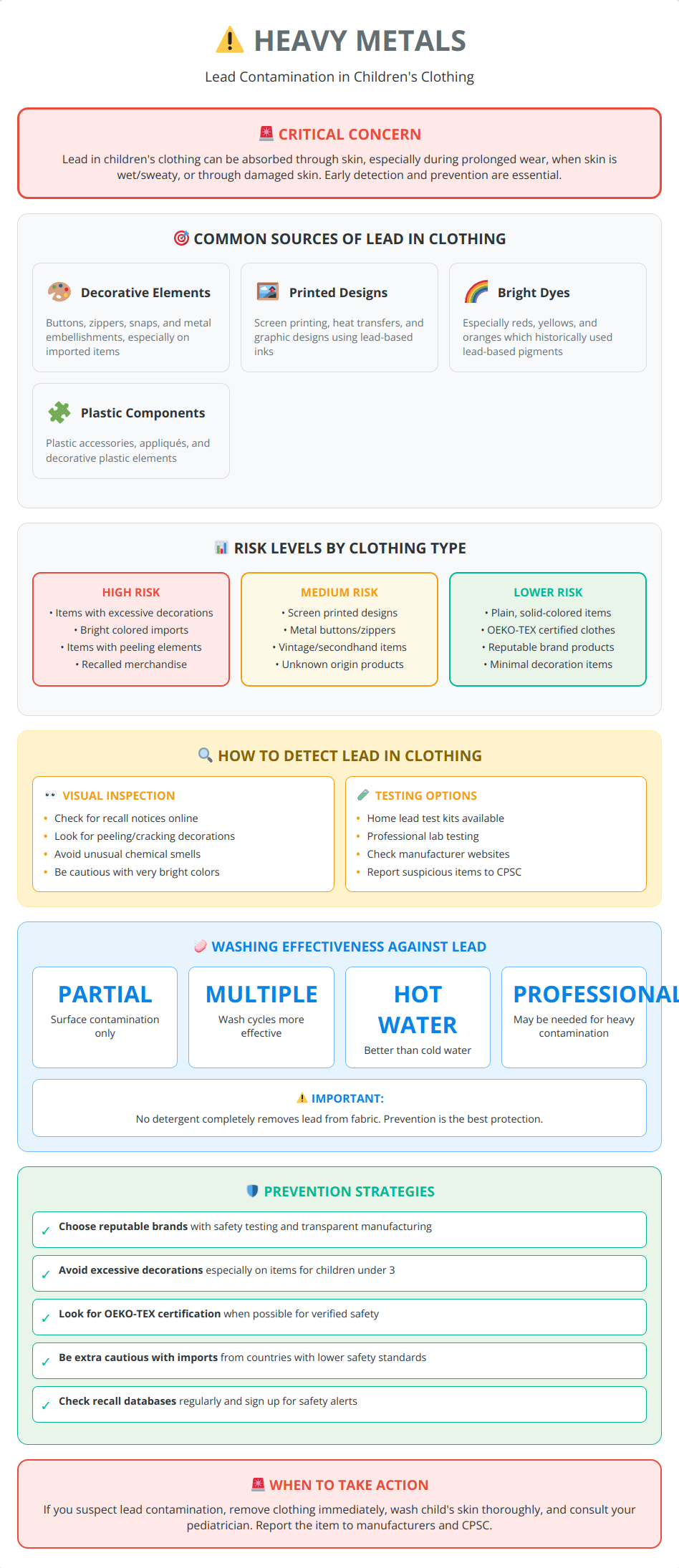
While concerning, understanding these risks empowers you to make safer choices and protect your child effectively.
Understanding the Lead Risk
The Consumer Product Safety Improvement Act requires that all children’s products comply with applicable safety rules and be tested by CPSC-accepted laboratories, with manufacturers required to provide written certificates of compliance.
Does lead in clothes wash out? Partially, but not completely. Lead in clothing typically comes from:
- Decorative elements like buttons and zippers
- Printed designs and screen printing
- Dyes used in bright colors
- Plastic components and accessories
Can lead in clothes be absorbed through the skin? Yes, especially:
- During prolonged wear
- When skin is wet or sweaty
- Through damaged or irritated skin
- In areas of high friction
Detecting Lead in Clothing
How can you tell if there is lead in your clothes?
- Look for recall notices on manufacturer websites
- Avoid items with peeling or cracking decorative elements
- Be cautious with very bright colors, especially reds and yellows
- Check for unusual chemical smells or metallic tastes on items
Which detergent removes lead from clothes? While no detergent completely removes lead:
- Heavy-duty detergents with surfactants help reduce surface contamination
- Hot water washing may remove more than cold
- Multiple wash cycles are more effective than single washes
- Professional cleaning may be necessary for heavy contamination
Prevention Strategies
Choosing safer options:
- Stick to reputable brands with safety testing
- Avoid items with excessive decorative elements
- Choose OEKO-TEX certified products when possible
- Be extra cautious with imported items
Building Your Pre-Washing Routine
Creating an efficient pre-washing system saves time, reduces stress, and ensures nothing gets forgotten. Here’s how to build yours:
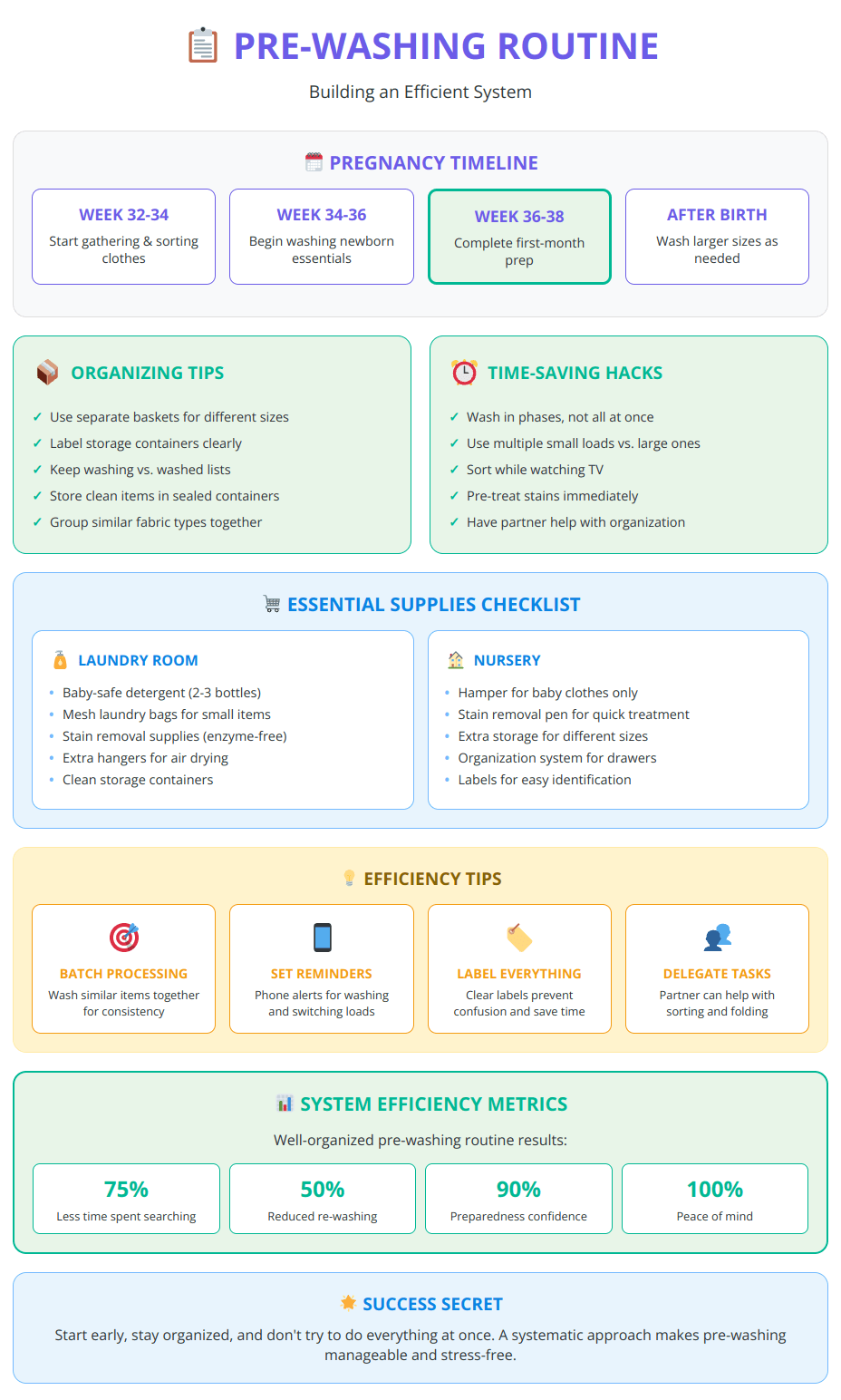
A well-organized system makes the entire process manageable and gives you confidence that you’re fully prepared.
Creating an Efficient System
Timing your pre-washing:
- Week 32-34 of pregnancy: Start gathering and sorting
- Week 34-36: Begin washing newborn essentials
- Week 36-38: Complete first-month clothing preparation
- After birth: Wash larger sizes as needed
Organization tips:
- Use separate laundry baskets for different sizes
- Label storage containers clearly
- Keep a list of what’s been washed vs. what needs washing
- Store clean items in sealed containers to prevent dust accumulation
Essential Supplies Checklist
For the laundry room:
- Baby-safe detergent (2-3 bottles to start)
- Mesh laundry bags for small items
- Stain removal supplies (enzyme-free options)
- Extra hangers for air drying
- Clean storage containers for sorted items
For the nursery:
- Hamper specifically for baby clothes
- Stain removal pen for quick treatment
- Extra storage for different sizes
- Organization systems for toddler clothes drawers
Frequently Asked Questions
For more comprehensive answers and expert guidance, try our Interactive Baby Clothes FAQ Tool with searchable categories and instant responses.
General Pre-Washing Questions
Can toddlers wear new clothes without washing?
No, toddlers should never wear new clothes without washing them first. Their sensitive skin and developing immune systems make them particularly vulnerable to the chemicals and contaminants found in unwashed clothing.
Do I need to wash baby clothes after buying?
Yes, always wash baby clothes after buying and before first use. This removes manufacturing chemicals, dust, and potential contaminants that accumulate during production and shipping.
Do new clothes need to be washed first?
Absolutely. New clothes contain manufacturing residues, chemical treatments for wrinkle resistance and color preservation, plus dust and particles from warehouses and stores.
Is it safe to wear clothes from the store without washing?
Adults may tolerate unwashed store clothes better than children, but it’s still not recommended. Children’s sensitive skin makes pre-washing essential for their safety and comfort.
Detergent and Safety Questions
Do baby clothes need to be washed in special detergent?
For the first 6-12 months, yes. Baby-specific or fragrance-free detergents are safer for sensitive skin. After age 1, many children can tolerate gentle, family-friendly formulations.
What is the safest laundry detergent for babies?
Look for detergents that are fragrance-free, dye-free, and hypoallergenic. Top choices include Dreft, All Free Clear, and Seventh Generation Baby. Always choose products recommended by pediatricians.
Is Ariel safe for baby clothes?
Ariel’s regular formulations contain fragrances and dyes that may irritate baby skin. If you choose Ariel, use their “Sensitive” or “Free & Clear” versions designed for sensitive skin.
Do you have to wash baby clothes in non-bio?
Non-biological (enzyme-free) detergents are gentler and less likely to cause skin reactions in babies. While not strictly required, they’re the safer choice for sensitive skin.
Specific Item Questions
Do you need to wash burp cloths before use?
Yes, burp cloths should always be washed before first use. They come into direct contact with baby’s face and mouth, making pre-washing essential for removing chemicals and ensuring absorbency.
How many burp cloths do I need?
Plan for 8-12 burp cloths minimum. Newborns spit up frequently, and you’ll need clean ones throughout the day while others are being washed.
How many diapers to take to the hospital?
Most hospitals provide diapers, but bring 2-3 days’ worth just in case. Newborns use 8-12 diapers daily, so pack 24-36 diapers for a 3-day stay.
Washing Frequency and Care
Do you need to wash baby clothes after every wear?
Yes, baby clothes should be washed after each wear due to frequent spit-ups, diaper leaks, and the baby’s developing immune system. Clean clothes help prevent skin irritation and maintain hygiene.
How often should newborns be bathed?
Newborns only need baths 2-3 times per week unless they have a diaper blowout or get particularly messy. Over-bathing can dry out their sensitive skin.
Should you wash socks inside out?
For adult socks, washing inside out helps preserve color and reduces pilling. For baby socks, it’s less critical, but it can help remove lint and debris that accumulates inside.
Fabric and Material Questions
Do I have to pre-wash fabric?
If you’re sewing baby clothes, always pre-wash fabric to remove sizing, chemicals, and to account for shrinkage. This ensures the finished garment is safe and fits properly.
Should you wash kids’ clothes before use?
Yes, all children’s clothes should be washed before first wear, not just baby clothes. Children’s skin remains more sensitive than adult skin throughout early childhood.
Can babies wear unwashed new clothes?
Never let babies wear unwashed new clothes. Their skin is extremely sensitive, and their tendency to put everything in their mouth makes chemical exposure particularly dangerous.
Emergency Situations: When You Haven’t Pre-Washed
Sometimes life doesn’t go according to plan. If you find yourself unprepared, here’s how to handle urgent situations safely:

While these are emergency measures, they can help keep your baby safe when proper preparation wasn’t possible.
When facing urgent situations, use our Emergency Response Flowchart for immediate step-by-step guidance.
If Baby Arrives Early
Quick wash protocol:
- Select absolute essentials only (2-3 outfits, receiving blankets)
- Use hot water if fabric allows (kills more bacteria)
- Add extra rinse cycle
- Air dry for fastest turnaround
- Have partner or family member handle while you focus on baby
Temporary alternatives:
- Hospital gowns for first few days
- Borrowed pre-washed items from friends/family
- Ask hospital about their clothing options
- Use receiving blankets as temporary clothing
Signs of Chemical Sensitivity
Watch for these reactions:
- Red, itchy, or bumpy skin after wearing new clothes
- Unusual fussiness when dressed
- Skin irritation in areas where clothing touches
- Respiratory symptoms like coughing or wheezing
Immediate response:
- Remove the clothing immediately
- Wash baby’s skin with lukewarm water
- Apply gentle, fragrance-free moisturizer
- Contact pediatrician if symptoms persist
- Wash the offending clothing multiple times before trying again
Seasonal Considerations
Different seasons bring unique challenges and considerations for washing your toddler’s clothes safely:
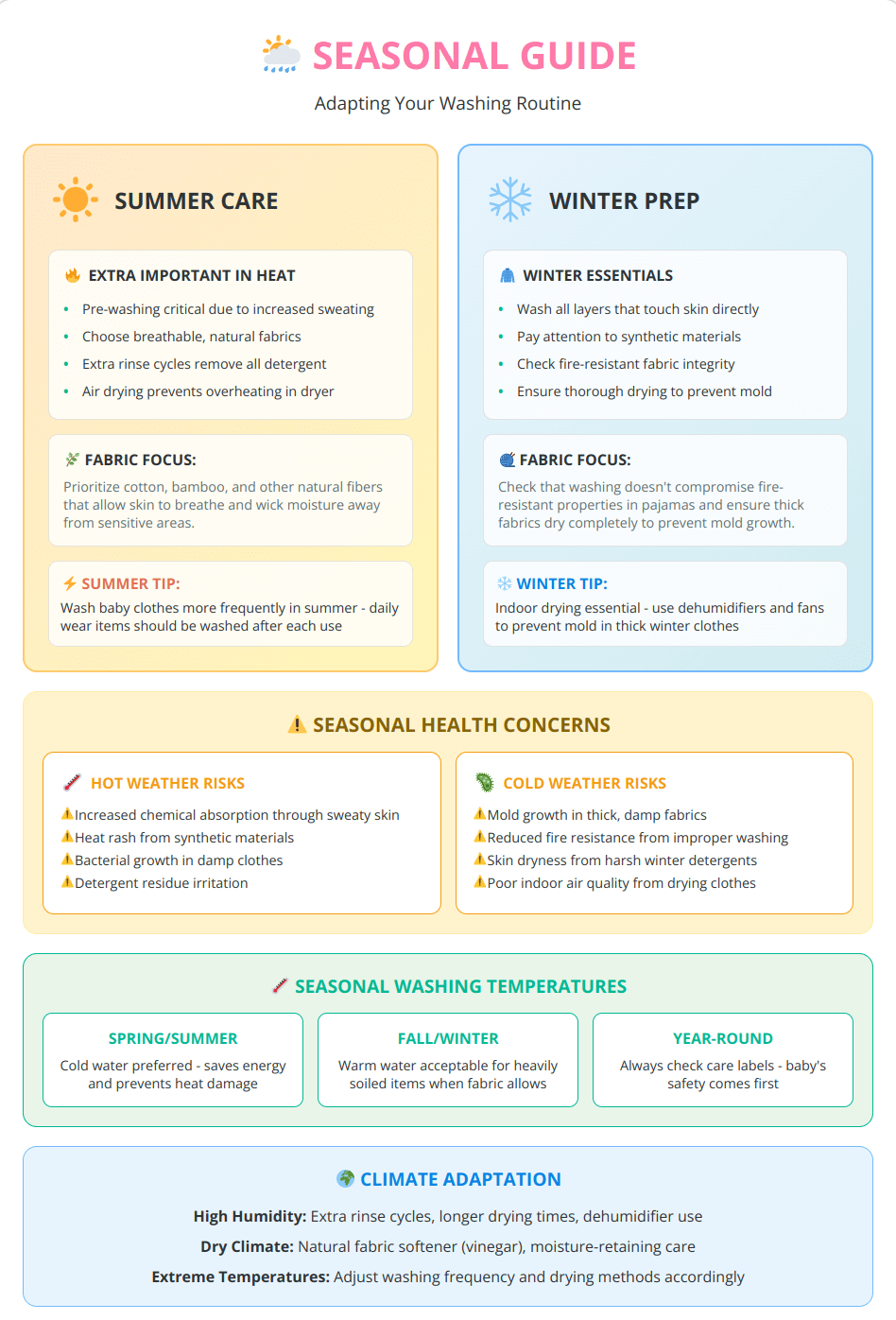
Adapting your routine to seasonal needs ensures your child stays comfortable and safe year-round.
Summer Clothing Care
For dressing toddlers for warm weather:
- Pre-wash is even more critical due to increased sweating
- Choose breathable, natural fabrics
- Extra rinse cycles help remove all detergent residue
- Air drying in summer prevents overheating in the dryer
Winter Preparation
When preparing winter clothes for babies:
- Wash all layers that touch skin directly
- Pay special attention to synthetic materials that may trap odors
- Check fire-resistant fabrics haven’t been compromised by washing
- Ensure thorough drying to prevent mold in thick fabrics
Cost-Effective Strategies
Keeping your baby’s clothes clean and safe doesn’t have to break the bank. Here are proven ways to save money while maintaining safety:

These strategies prove that the safest practices for your baby are often the most economical choices for your family.
Budget-Friendly Pre-Washing
Money-saving tips:
- Buy concentrated, baby-safe detergents in bulk
- Use slightly less detergent than recommended
- Air dry to save energy costs
- Wash similar items together to maximize load efficiency
When to invest more:
- Quality detergent pays off in gentleness and effectiveness
- OEKO-TEX certified clothing may cost more upfront but offers peace of mind
- Professional cleaning for special items can extend their life
Making Your Own Baby-Safe Cleaners
Simple recipe for sensitive skin:
- 1 cup grated castile soap
- 1/2 cup baking soda
- 1/4 cup white vinegar (added to rinse cycle)
- Mix soap and baking soda for washing powder
Natural stain removal:
- Lemon juice and salt for organic stains
- Hydrogen peroxide for protein-based stains
- Baking soda paste for odor removal
Environmental Impact and Sustainability
Making eco-friendly choices while keeping your baby safe doesn’t have to be complicated. Here’s how to minimize your environmental impact:
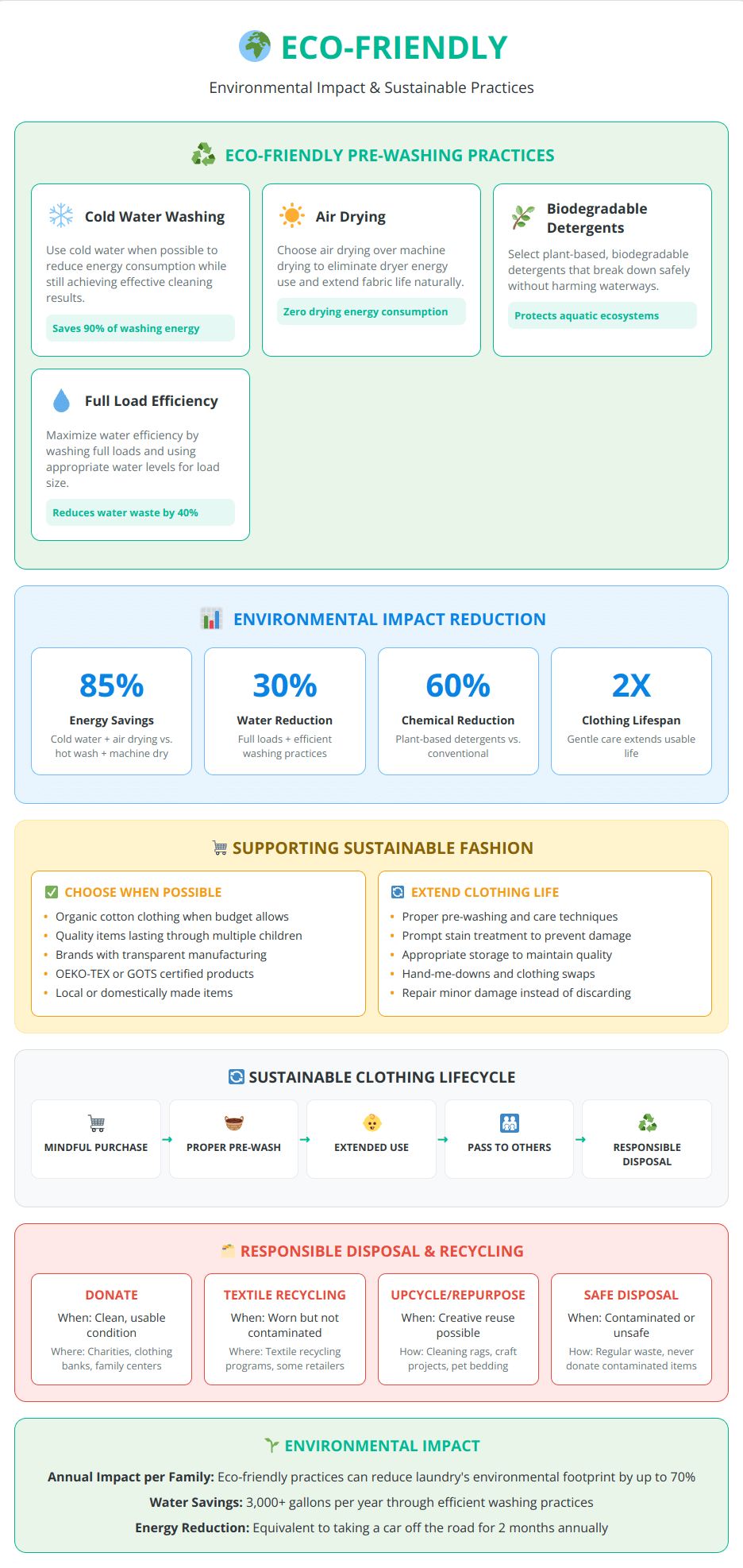
These sustainable practices prove that what’s best for your baby can also be best for the planet.
Eco-Friendly Pre-Washing Practices
Reducing environmental impact:
- Use cold water when possible (saves energy)
- Choose biodegradable, plant-based detergents
- Air dry instead of using the dryer
- Wash full loads to maximize water efficiency
Supporting sustainable fashion:
- Choose organic vs conventional infant clothing when budget allows
- Buy quality items that last through multiple children
- Consider sustainable newborn fashion trends
- Support brands with transparent manufacturing practices
Disposal and Recycling
When clothes can’t be cleaned safely:
- Don’t donate items with permanent chemical odors
- Recycle fabric when possible
- Properly dispose of heavily contaminated items
- Learn where to donate toddler clothes near you for clean, usable items
Technology and Innovation
Modern technology is making baby clothing care safer and more efficient than ever. Here’s what’s available now and coming soon:

These technological advances represent exciting progress in making baby care both easier for parents and safer for children.
Smart Washing Solutions
Modern washing machine features:
- Steam cycles help remove chemicals more effectively
- Sanitize cycles use higher temperatures safely
- Extra rinse options ensure thorough cleaning
- Allergen cycles specifically designed for sensitive skin
Apps and tools:
- Washing reminder apps for busy parents
- Stain identification apps with treatment suggestions
- Load calculation tools for optimal detergent use
Future Trends in Baby Clothing Safety
Emerging developments:
- Blockchain tracking for chemical-free supply chains
- Advanced testing methods for faster contamination detection
- New fabric treatments that are inherently safer
- Improved certification standards and transparency
Conclusion
Washing toddler clothes before first use isn’t just a good idea—it’s an essential step in protecting your child’s health and comfort. The research is clear: new clothing contains numerous chemicals, contaminants, and potential irritants that can harm sensitive skin and developing immune systems. From formaldehyde and PFAS to heavy metals and harsh dyes, the risks are real and well-documented.
The good news is that proper pre-washing removes up to 60% of these harmful substances, making this simple step one of the most effective ways to protect your child. By following the guidelines in this comprehensive guide, you can create a safe, healthy environment for your toddler while establishing good laundry habits that will serve your family for years to come.
Key Recommendations Summary
Essential actions every parent should take:
- Always pre-wash new clothes 4-6 weeks before your baby’s due date or immediately after purchasing for older children
- Choose baby-safe detergents that are fragrance-free, dye-free, and hypoallergenic
- Look for safety certifications like OEKO-TEX Standard 100 when shopping for new clothes
- Wash all secondhand items thoroughly regardless of their apparent cleanliness
- Use proper washing techniques including appropriate temperatures, cycles, and drying methods
- Stay vigilant for sensitivity reactions and adjust your routine accordingly
- Transition gradually to regular detergents as your child’s skin develops tolerance
Long-term benefits of proper pre-washing:
- Reduced risk of skin irritation and allergic reactions
- Better sleep quality for both baby and parents
- Longer-lasting clothing that maintains its appearance
- Peace of mind knowing you’ve taken every precaution
- Healthy habits that benefit the entire family
Remember, every child is different, and what works for one family may need adjustment for another. Stay flexible, observe your child’s responses, and don’t hesitate to consult your pediatrician if you notice any concerning skin reactions or sensitivities.
The small investment of time and effort in properly pre-washing your toddler’s clothes pays enormous dividends in your child’s health, comfort, and wellbeing. By making informed choices about detergents, understanding the risks of chemical contamination, and following proper washing procedures, you’re giving your child the best possible start in life.
As your child grows, these practices will evolve, but the foundation of safety and care you establish now will serve your family well into the future. Remember that parenting is about making the best decisions you can with the information available, and by following these evidence-based guidelines, you’re doing exactly that.
Final takeaway: When in doubt, wash it out. Your child’s health is worth the extra load of laundry, and the peace of mind that comes from knowing you’ve taken every reasonable precaution is invaluable. Safe, clean clothes are just one part of creating a healthy environment for your growing toddler, but they’re an important part that’s entirely within your control.



